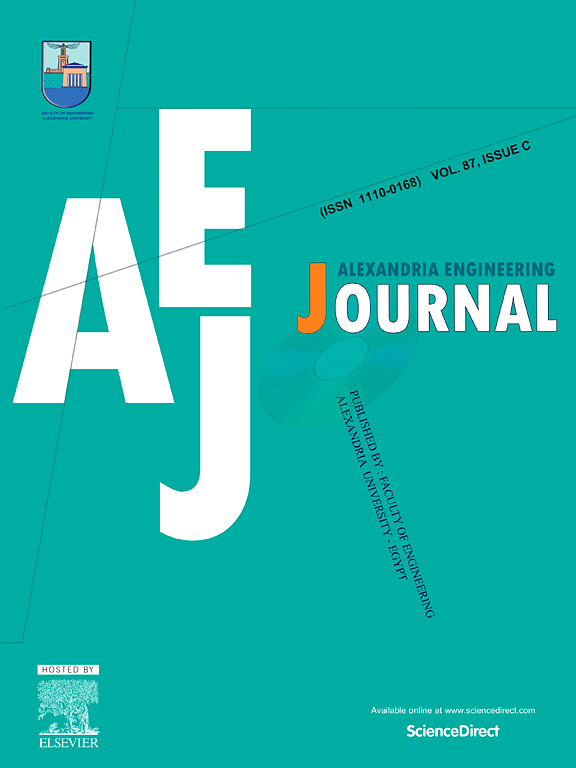A novel model for investigating the thermal equilibrium characteristics of a high-speed train gearbox
IF 6.2
2区 工程技术
Q1 ENGINEERING, MULTIDISCIPLINARY
引用次数: 0
Abstract
Accurate analysis of the thermal equilibrium characteristics of high-speed train gearboxes can aid in preventing high-temperature malfunctions and ensuring the safe and efficient operation of trains. Owing to the complex heat transfer routes and interdependencies within the gearbox, establishing a precise thermal analysis model is essential. In this work, a finite element thermal network model is proposed to predict the temperature distribution of a gearbox. The moving particle semi-implicit method is used to determine the flow state of the lubricant and the convective heat transfer coefficients on the surfaces of the components. Power loss, which contributes to heat generation, is categorized into gear meshing, oil churning, and bearing friction. A thermal network model and finite element model for thermal analysis are subsequently developed based on heat transfer relationship, and data exchange between the two models is achieved through the BoundaryToFEM unit. The effects of the gear rotation speed, convective heat transfer coefficient between the components and lubricant, and heat transfer coefficient between the outer surface of the gearbox and ambient air on the thermal equilibrium are analyzed. The results indicate that when the input gear speed increases from 2104 rpm to 5259 rpm, the total power loss increases by 2159 W, and the heat balance temperature increases by approximately 53 °C. When the convective heat transfer coefficient between the components and lubricant varies from a 50 % reduction to a 50 % magnification, the thermal equilibrium temperature only changes by 1–2 °C. However, when t between the outer surface of the gearbox and ambient air undergoes the same variation process, the thermal equilibrium temperature decreases by approximately 82 °C. The full-scale gearbox running-in experiment shows that the predicted temperatures of the bearing cups remained within a deviation range of 2–5 % from the experimental values, and the maximum error of the lubricant temperature was 3.18 °C, which further verifies the accuracy and reliability of the proposed model.
研究高速列车齿轮箱热平衡特性的新模型
准确分析高速列车齿轮箱的热平衡特性,有助于防止列车发生高温故障,保证列车安全高效运行。由于变速箱内部复杂的传热路线和相互依赖关系,建立精确的热分析模型至关重要。本文提出了一种有限元热网络模型来预测齿轮箱的温度分布。采用运动粒子半隐式方法确定了润滑油的流动状态和部件表面的对流换热系数。功率损失,这有助于热的产生,被分类为齿轮啮合,油搅拌,和轴承摩擦。基于传热关系建立了热网络模型和热分析有限元模型,并通过BoundaryToFEM单元实现了两种模型之间的数据交换。分析了齿轮转速、部件与润滑油之间的对流换热系数、齿轮箱外表面与周围空气之间的换热系数对热平衡的影响。结果表明,当输入齿轮转速从2104 rpm增加到5259 rpm时,总功率损失增加2159 W,热平衡温度升高约53℃。当组件和润滑剂之间的对流换热系数从50% %减小到50% %放大时,热平衡温度仅变化1-2°C。然而,当齿轮箱外表面与周围空气之间的t经历相同的变化过程时,热平衡温度降低了约82℃。齿轮箱全尺寸磨合实验表明,轴承杯的预测温度与实验值的偏差在2-5 %范围内,润滑油温度的最大误差为3.18℃,进一步验证了所提模型的准确性和可靠性。
本文章由计算机程序翻译,如有差异,请以英文原文为准。
求助全文
约1分钟内获得全文
求助全文
来源期刊

alexandria engineering journal
Engineering-General Engineering
CiteScore
11.20
自引率
4.40%
发文量
1015
审稿时长
43 days
期刊介绍:
Alexandria Engineering Journal is an international journal devoted to publishing high quality papers in the field of engineering and applied science. Alexandria Engineering Journal is cited in the Engineering Information Services (EIS) and the Chemical Abstracts (CA). The papers published in Alexandria Engineering Journal are grouped into five sections, according to the following classification:
• Mechanical, Production, Marine and Textile Engineering
• Electrical Engineering, Computer Science and Nuclear Engineering
• Civil and Architecture Engineering
• Chemical Engineering and Applied Sciences
• Environmental Engineering
 求助内容:
求助内容: 应助结果提醒方式:
应助结果提醒方式:


